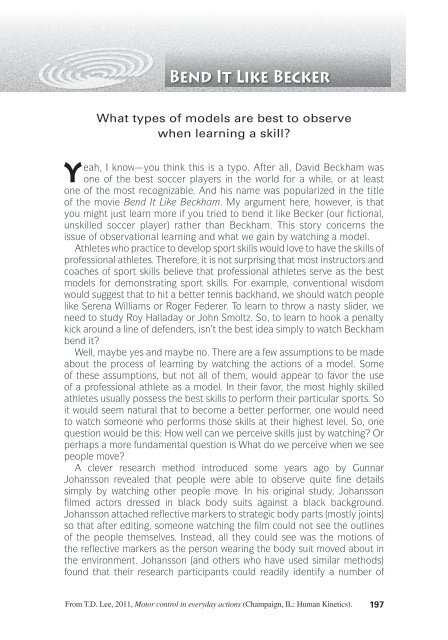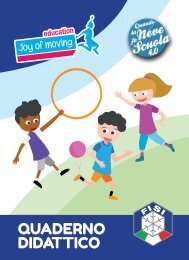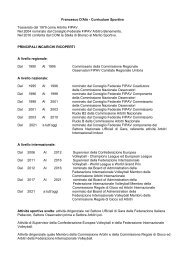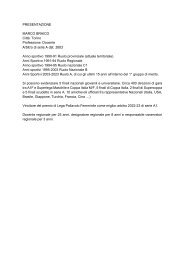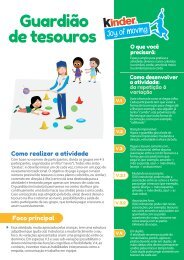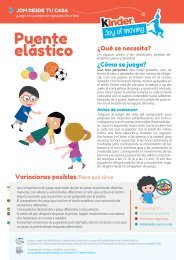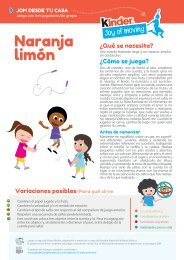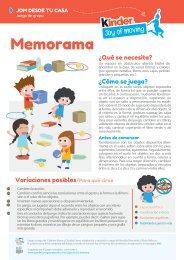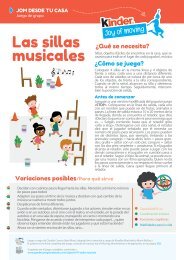You also want an ePaper? Increase the reach of your titles
YUMPU automatically turns print PDFs into web optimized ePapers that Google loves.
<strong>Bend</strong> <strong>It</strong> <strong>Like</strong> <strong>Becker</strong><br />
What types of models are best to observe<br />
when learning a skill?<br />
Y<br />
eah, I know—you think this is a typo. After all, David Beckham was<br />
one of the best soccer players in the world for a while, or at least<br />
one of the most recognizable. And his name was popularized in the title<br />
of the movie <strong>Bend</strong> <strong>It</strong> <strong>Like</strong> Beckham. My argument here, however, is that<br />
you might just learn more if you tried to bend it like <strong>Becker</strong> (our fictional,<br />
unskilled soccer player) rather than Beckham. This story concerns the<br />
issue of observational learning and what we gain by watching a model.<br />
Athletes who practice to develop sport skills would love to have the skills of<br />
professional athletes. Therefore, it is not surprising that most instructors and<br />
coaches of sport skills believe that professional athletes serve as the best<br />
models for demonstrating sport skills. For example, conventional wisdom<br />
would suggest that to hit a better tennis backhand, we should watch people<br />
like Serena Williams or Roger Federer. To learn to throw a nasty slider, we<br />
need to study Roy Halladay or John Smoltz. So, to learn to hook a penalty<br />
kick around a line of defenders, isn’t the best idea simply to watch Beckham<br />
bend it?<br />
Well, maybe yes and maybe no. There are a few assumptions to be made<br />
about the process of learning by watching the actions of a model. Some<br />
of these assumptions, but not all of them, would appear to favor the use<br />
of a professional athlete as a model. In their favor, the most highly skilled<br />
athletes usually possess the best skills to perform their particular sports. So<br />
it would seem natural that to become a better performer, one would need<br />
to watch someone who performs those skills at their highest level. So, one<br />
question would be this: How well can we perceive skills just by watching? Or<br />
perhaps a more fundamental question is What do we perceive when we see<br />
people move?<br />
A clever research method introduced some years ago by Gunnar<br />
Johansson revealed that people were able to observe quite fine details<br />
simply by watching other people move. In his original study, Johansson<br />
filmed actors dressed in black body suits against a black background.<br />
Johansson attached reflective markers to strategic body parts (mostly joints)<br />
so that after editing, someone watching the film could not see the outlines<br />
of the people themselves. Instead, all they could see was the motions of<br />
the reflective markers as the person wearing the body suit moved about in<br />
the environment. Johansson (and others who have used similar methods)<br />
found that their research participants could readily identify a number of<br />
From T.D. Lee, 2011, Motor control in everyday actions (Champaign, IL: Human Kinetics).<br />
197
198 Motor Control in Everyday Actions<br />
features from the motions of the people on the video. For example, they<br />
could distinguish males from females, recognize friends, and even identify<br />
different types of animals from their gaits.<br />
More recently, researchers have shown that various actions are identifiable,<br />
too, just from watching the motions of these white dots. Actions such as<br />
kicking a soccer ball, throwing a ball, and jumping were all readily perceived<br />
just from the movement of white dots on a video screen. These experiments<br />
demonstrate quite conclusively that humans have the capability to perceive<br />
fine details of temporal and spatial activities, even when provided quite<br />
restricted visual information.<br />
Clearly, we must be good at picking up much more information from<br />
watching full videos rather than just watching moving dots. So, the answer<br />
to my earlier question is yes, we can perceive motor skills just by watching.<br />
However, does watching a professional athlete perform skills provide the<br />
optimal opportunity to learn? This is a difficult question to answer, because<br />
it presupposes that the average observer knows what to look at and what to<br />
look for. But that is not necessarily so. The research on this question suggests<br />
that skilled athletes serve as the best models for those who already possess<br />
some skill in the activity. Learning is facilitated even more if an instructor can<br />
help the observer attend to specific features displayed by the model.<br />
But, another research area suggests that watching completely unskilled<br />
models can be a useful learning tool as well. This is especially true if, for<br />
example, the model is a member of a beginner-level skills class and the<br />
instructor has asked that person to demonstrate some activity to the rest of<br />
the class. In this situation, the instructor can point out specific faults to both<br />
the model and those who are observing the model. The unskilled model<br />
demonstrates something that might be wrong, and the observers get to see<br />
what the model has performed. Most important, the observers also receive<br />
the augmented feedback provided by the instructor about the error that was<br />
made, and then are engaged in watching the model attempt to correct the<br />
error. This is a powerful observational learning situation because it engages<br />
the observer in the problem-solving process that captures the trial-and-error<br />
activities of the learner.<br />
So, should we watch Beckham or <strong>Becker</strong> bend it? The conventional<br />
wisdom would suggest Beckham. From a motor learning perspective,<br />
however, there may be as much or more benefit from watching the unskilled<br />
<strong>Becker</strong> as there is from watching the very skilled Beckham, especially if the<br />
observers are novice learners.<br />
Self-Directed Learning Activities<br />
1. Define the term observational learning in your own words.<br />
2. Identify a skill that would be difficult to model effectively, and one that<br />
would be easy to model. What is it about these skills that makes them<br />
easy or difficult to model?<br />
From T.D. Lee, 2011, Motor control in everyday actions (Champaign, IL: Human Kinetics).
Skill Development<br />
199<br />
3. The story considers model skill as an important characteristic in the<br />
observational learning process. Identify four other model characteristics<br />
that could have an impact on observational learning.<br />
4. Identify a research methodology you could use to assess the impact of<br />
one of the model characteristics that you identified in question 3.<br />
Notes<br />
• The following websites have examples of point-light displays of biological<br />
motion:<br />
www.tinyurl.com/pointlight1<br />
www.tinyurl.com/pointlight2<br />
www.tinyurl.com/pointlight3<br />
• Some very interesting observational learning research was conducted<br />
using point-light display techniques to model soccer skills, including this<br />
one:<br />
Horn, R.R., Scott, M.A., Williams, A.M., & Hodges, N.J. (2005). Visual<br />
search and coordination changes in response to video and pointlight<br />
demonstrations without KR. Journal of Motor Behavior, 37,<br />
265-274.<br />
Suggested Readings<br />
Hodges, N.J., & Franks, I.M. (2002). Modelling coaching practice: The role<br />
of instruction and demonstration. Journal of Sports Sciences, 20, 793-<br />
811.<br />
Janelle, C.M., Champenoy, J.D., Coombes, S.A., & Mousseau, M.B. (2003).<br />
Mechanisms of attentional cueing during observational learning to<br />
facilitate skill acquisition. Journal of Sports Sciences, 21, 825-838.<br />
Johansson, G. (1973). Visual perception of biological motion and a model<br />
for its analysis. Perception & Psychophysics, 14, 201-211.<br />
McCullagh, P., & Weiss, M.R. (2001). Modeling: Considerations for motor<br />
skill performance and psychological responses. In R.N. Singer, H.A.<br />
Hausenblas, & C.M. Janelle (Eds.), Handbook of sport psychology (2nd<br />
ed., pp. 205-238). New York: Wiley.<br />
Schmidt, R.A., & Lee, T.D. (2011). Conditions of practice. In Motor control<br />
and learning: A behavioral emphasis (5th ed., pp. 347-392). Champaign,<br />
IL: Human Kinetics.<br />
From T.D. Lee, 2011, Motor control in everyday actions (Champaign, IL: Human Kinetics).


